Isotonic solutions Study guides, Class notes & Summaries
Looking for the best study guides, study notes and summaries about Isotonic solutions? On this page you'll find 2237 study documents about Isotonic solutions.
Page 3 out of 2.237 results
Sort by
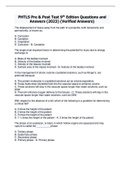
-
PHTLS Pre & Post Test 9th Edition Questions and Answers (2023) (Verified Answers)
- Exam (elaborations) • 15 pages • 2023
-
- $10.49
- 1x sold
- + learn more
The displacement of tissue away from the path of a projectile, both temporarily and permanently, is known as: A. Conization B. Cavitation C. Crepitation D. Contusion - B. Cavitation The single most important factor in determining the potential for injury due to energy exchange is: A. Mass of the bodies involved B. Velocity of the bodies involved C. Density of the tissues involved D. Surface area of the impact involved - B. Velocity of the bodies involved In the managem...
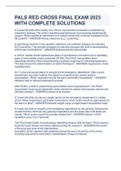
-
PALS RED CROSS FINAL EXAM 2023 WITH COMPLETE SOLUTIONS
- Exam (elaborations) • 6 pages • 2023
- Available in package deal
-
- $11.49
- 1x sold
- + learn more
PALS RED CROSS FINAL EXAM 2023 WITH COMPLETE SOLUTIONS A 5-year-old child with a history of a chronic neuromuscular disease is experiencing respiratory distress. The child is breathing spontaneously and receiving supplemental oxygen. Which additional intervention is a critical component of airway management for this patient? - ANSWER-Airway clearance (e.g., suctioning) A child being cared for in the pediatric telemetry unit suddenly displays the following ECG waveform. The provider prepare...
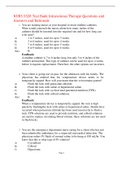
-
NURS 3320 Test Bank Intravenous Therapy Questions and Answers and Rationale,100% CORRECT
- Exam (elaborations) • 23 pages • 2022
-
- $15.99
- 1x sold
- + learn more
NURS 3320 Test Bank Intravenous Therapy Questions and Answers and Rationale 1. You are training nurses at your hospital to insert midline catheters. What would you teach the nurses about how many inches of the catheter should be inserted into the required site and for how long can it be used? A) 1 to 3 inches, used for up to 3 weeks B) 3 to 6 inches, used for up to 4 weeks C) 7 to 8 inches, used for up to 5 weeks D) 8 to 9 inches, used for up to 6 weeks Ans: B Feedback: A midline cathete...
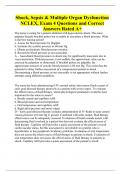
-
Shock, Sepsis & Multiple Organ Dysfunction NCLEX, Exam 4 Questions and Correct Answers Rated A+
- Exam (elaborations) • 74 pages • 2023
-
- $11.99
- 1x sold
- + learn more
The nurse is caring for a patient admitted with hypovolemic shock. The nurse palpates thready brachial pulses but is unable to auscultate a blood pressure. What is the best nursing action? a. Assess the blood pressure by Doppler. b. Estimate the systolic pressure as 60 mm Hg. c. Obtain an electronic blood pressure monitor. d. Record the blood pressure as not assessable. A ~ Auscultated blood pressures in shock may be significantly inaccurate due to vasoconstriction. If blood pressure is not...
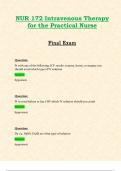
-
NUR172 / NUR 172 Final Exam (Latest 2024 / 2025): Intravenous Therapy for the Practical Nurse | Questions and Verified Answers | Already Graded A - Hondros
- Exam (elaborations) • 29 pages • 2024
- Available in package deal
-
- $7.99
- + learn more
Final Exam: NUR172 / NUR 172 (Latest 2024 / 2025) Intravenous Therapy for the Practical Nurse Exam | Questions and Verified Answers | Already Graded A – Hondros Q: Pt with any of the following: ICP, stroke, trauma, burns, or surgery you should avoid which type of IV solution Answer: hypotonic Q: Pt in renal failure or has CHF which IV solution should you avoid Answer: hypertonic Q: D5 1/2, D5NS, D5LR are what type of solution Answer: hypertonic Q: NS, LR, D5W are what type of solution Answer: ...
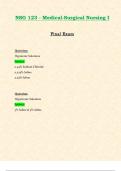
-
NSG123 / NSG 123 Final Exam (Latest 2024 / 2025 Update): Medical-Surgical Nursing I | Review with Questions and Verified Answers | 100% Correct - Herzing
- Exam (elaborations) • 54 pages • 2024
- Available in package deal
-
- $7.99
- + learn more
Final Exam: NSG123 / NSG 123 (Latest 2024 / 2025 Update) Medical-Surgical Nursing I | Review with Questions and Verified Answers | 100% Correct - Herzing Q: Hypotonic Solutions Answer: 0.45% Sodium Chloride 0.225% Saline 0.33% Saline Q: Hypertonic Solutions Answer: 3% Saline & 5% Saline Q: Isotonic Solutions Answer: Normal Saline (0.9% Saline) Lactated Ringer 5% Dextrose in Water Q: Phlebitis Definition Correct- Herzing Answer: Phlebitis is characterized by a reddened, warm area around the inser...
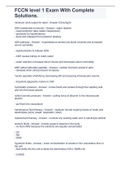
-
FCCN level 1 Exam With Complete Solutions.
- Exam (elaborations) • 13 pages • 2022
-
- $13.99
- 4x sold
- + learn more
minimum urine output for adult 0.5mL/kg/hr ADH (antidiuretic hormone) - water retainer - vasoconstrictor (also called Vasopressin) - produced by hypothalamus - store and released from posterior pituitary ADH pathway - hypothalamus senses low blood volumed and increased serum osmolality - signal pituitary to release ADH - ADH causes kidney to retain water - water retention increases blood volume and decreases serum osmolality ANP (atrial natriuretic peptide) -...
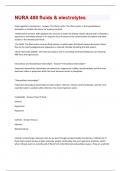
-
NURA 408 fluids & electrolytes Exam Questions With 100% Correct Answers.
- Exam (elaborations) • 19 pages • 2024
- Available in package deal
-
- $8.39
- + learn more
Fluid regulation mechanisms - Answer--The thirst center. The thirst center in the hypothalamus stimulates or inhibits the desire for a person to drink. -Antidiuretic hormone. ADH regulates the amount of water the kidney tubules absorb and is released in response to low blood volume or in response to an increase in the concentration of sodium and other solutes in the intravascular fluids. -The RAAS. The RAA system controls fluid volume, in which when the blood volume decreases, blood flow t...
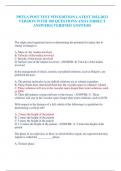
-
PHTLS POST TEST 9TH EDITION LATEST 2022-2023 VERSION WITH 100 QUESTIONS AND CORRECT ANSWERS| VERIFIED ANSWERS
- Exam (elaborations) • 22 pages • 2024
-
- $17.99
- + learn more
PHTLS POST TEST 9TH EDITION LATEST VERSION WITH 100 QUESTIONS AND CORRECT ANSWERS| VERIFIED ANSWERS. The single most important factor in determining the potential for injury due to energy exchange is: A. Mass of the bodies involved B. Velocity of the bodies involved C. Density of the tissues involved D. Surface area of the impact involved - ANSWER- B. Velocity of the bodies involved In the management of shock, isotonic crystalloid solutions, such as Ringer's, are preferred because: A. The pro...
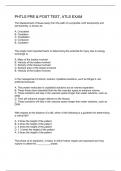
-
PHTLS PRE & POST TEST, ATLS EXAM
- Exam (elaborations) • 28 pages • 2024
-
- $13.99
- + learn more
The displacement of tissue away from the path of a projectile, both temporarily and permanently, is known as: A. Conization B. Cavitation C. Crepitation D. Contusion B. Cavitation The single most important factor in determining the potential for injury due to energy exchange is: A. Mass of the bodies involved B. Velocity of the bodies involved C. Density of the tissues involved D. Surface area of the impact involved B. Velocity of the bodies involved In the management of ...

Did you know that on average a seller on Stuvia earns $82 per month selling study resources? Hmm, hint, hint. Discover all about earning on Stuvia


